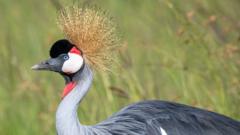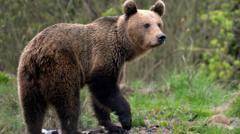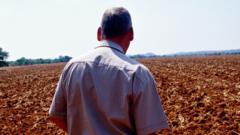The crested crane, a symbol of Uganda's identity, is on the brink of extinction due to a drastic decline in its population, primarily driven by habitat encroachment and conflicts with local farmers. Conservation efforts are underway, but the continued threats pose significant challenges.
Urgent Measures Needed to Save Uganda's Iconic Crested Crane from Extinction

Urgent Measures Needed to Save Uganda's Iconic Crested Crane from Extinction
With its striking appearance and cultural significance, the crested crane faces severe threats from habitat loss and farmer conflicts that jeopardize its future in Uganda.
The crested crane, renowned for its stunning golden crown and elegant demeanor, is more than just Uganda's national bird; it represents a rich cultural heritage and is emblematic of the nation’s identity. Once flourishing with over 100,000 individuals in the 1970s, the population has plummeted to about 10,000 today, placing it on the International Union for Conservation of Nature's (IUCN) red list of endangered species since 2012. The decline is alarming, revealing a staggering 80% decrease across eastern Africa in the past 25 years.
Legally protected against hunting—violators can face life sentences and fines of up to 20 billion Ugandan shillings ($5 million)—the crested crane was traditionally viewed as sacred among Buganda cultural beliefs. However, that reverence has waned among the farming communities in western Uganda where the birds are now seen as pests. Farmers like Tom Mucunguzi express frustration, stating, "I really don't see any value in these birds because all they do is raid our plantations and eat our crops."
As the human population increases and the need for land escalates, farmers are encroaching on the cranes' natural wetlands, diminishing their habitats. Both maize and rice farmers have resorted to poisoning the birds, leading to significant casualties among the crane population. Gilbert Tayebwa of the International Crane Foundation (ICF) emphasizes the urgent need for alternative solutions, suggesting scarecrows as a humane deterrent.
Despite the challenges, some community members still recognize the crane's importance. Farmer Philip Ntare acknowledges the cultural implications of killing the bird but expresses concern about crop damage without government compensation. Unfortunately, John Makombo from the Uganda Wildlife Authority states that the government cannot be held responsible for damages caused by wildlife, asserting the bird's freedom to roam is paramount.
Crested cranes are also vulnerable to predation and habitat loss, exacerbated by human activities. Increasingly hostile environmental factors, such as flooding and power line hazards, coupled with threats from traditional practices that aim to capture the birds for beliefs in luck and marital fidelity, further complicate their survival.
Conservation efforts are underway, with local organizations rallying to restore wetland habitats and combat illegal hunting. President Yoweri Museveni has called for a national focus on wetland conservation in 2025, hoping to reverse the cranes' declining fortunes. While conservationists recognize incremental successes, they warn that the situation remains critical.
As the crested crane's fate hangs in the balance, urgent measures must be taken to protect this iconic symbol of Uganda before it loses its rightful place in the nation's ecosystem. The cooperation of local communities, farmers, and government agencies will be essential in ensuring a future for the crested crane, safeguarding it for generations to come.





















